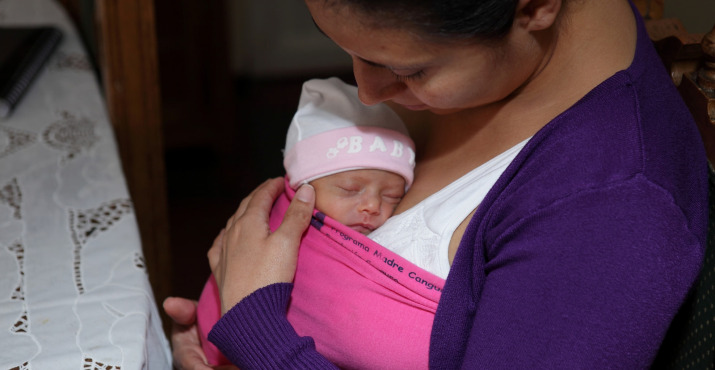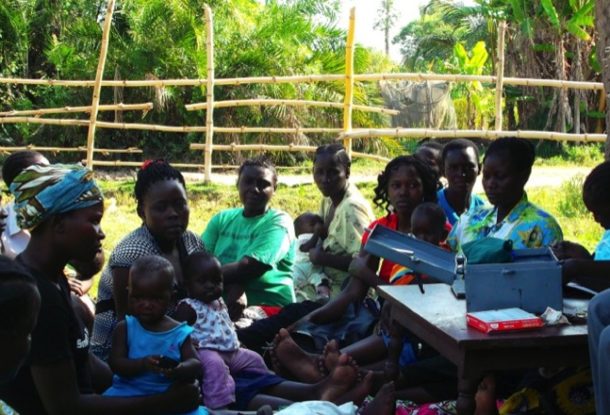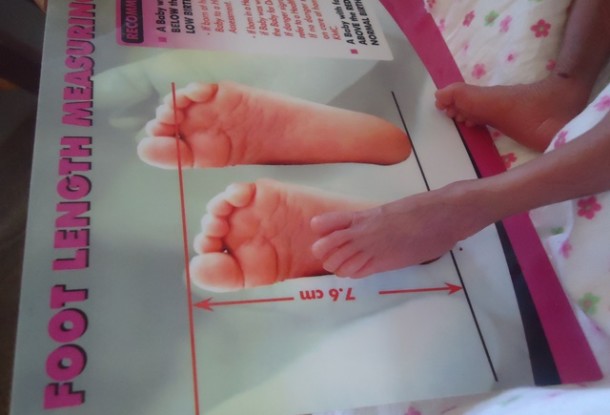Innovation Summary
 Children born prematurely are much more susceptible to developmental damage than infants who complete their term. This damage can lead to long-term adverse effects on neurodevelopment. The aim of this segment of the Kangaroo Mother Care (KMC) study is to understand the adverse effects of prematurity on neuro- and human development by comparing general health, brain functioning, integrity and intellectual performance, and social adjustment between young adults who were born prematurely.
Children born prematurely are much more susceptible to developmental damage than infants who complete their term. This damage can lead to long-term adverse effects on neurodevelopment. The aim of this segment of the Kangaroo Mother Care (KMC) study is to understand the adverse effects of prematurity on neuro- and human development by comparing general health, brain functioning, integrity and intellectual performance, and social adjustment between young adults who were born prematurely.
In the previous segment of the study, which took place between 1994 and 1996, premature babies were randomly assigned to either the KMC program or traditional care in incubators. The KMC intervention consisted of using mothers as incubators, and as the main source of food and stimulation. This intervention has now evolved into a program used in over 34 countries.
Children who were part of the original study are now 18 years old. Their neurodevelopment will be assessed using neuroimaging (structural, functional and Tractography images) to quantify the impact of KMC on child development.
Gallery
Impact
- 746 newborns <2000g were randomized—382 to KMC and 364 to traditional care, as part of the first segment of the study.
- ~ 450 assessments will be conducted on children, now 18 years old, that received either the intervention or traditional care as part of the first segment of the study.
- 20 million infants per year (90% born in low and middle income countries) are candidates to take advantage of the KMC method.
"KMC: a strategy to decrease the mortality of the low birth weight infant in the world."
-- Nathalie Charpak
Innovation
Between 1994-1996, the Kangaroo Foundation team conducted a randomized controlled trial to create a solution to counter the adverse effects of development, related to prematurity. The control arm received traditional care in incubators while the intervention arm received the Kangaroo Mother Care (KMC) program consisting of the following components:
Infant held in Kangaroo Position
Skin-to-skin contact between mother and infant, 24 hr a day. The baby is held in a strict up-right position, between the mother’s breasts and under her clothes. Mothers are employed as “incubators” and as the main source of food and stimulation.
“Kangaroo” Nutrition: Exclusive Breast Feeding
Exclusive or nearly exclusive breast feeding based on infants needs rather than free demand. The goal is to achieve an optimal weight gain of 15 grams per kilogram per day until the infants reach term. If despite receiving exclusive breast feeding, the infant is not gaining weight at the desired rate, a supplement (preterm infant formula) is administered by dropper or spoon.
“Kangaroo” Discharge and Follow-Up Policies up to 40 Week
LBW infants are eligible for both kangaroo position and kangaroo nutrition as soon as they overcome major adaptation problems to extra-uterine life, are thriving in a neutral thermal environment, and are able to suck and swallow properly. As soon as the infant successfully adapts the kangaroo position, which can occur anywhere from a few hours to a few days after birth, the infants and their mothers are discharged regardless of the infant’s weight or gestational age. At home, infants are kept in the kangaroo position until they do not accept it anymore. After discharge, infants are monitored daily until they recover their birth weight and are gaining at least 15-20 grams per kilogram per day. Afterwards, weekly visits are scheduled until term (40 weeks of PCA).
Collaboration
Original Funders of the KMC Method
- Edgar Rey Sanabria (Colombia)
- Luis Navarete (Colombia)
- Hector Martinez (Colombia)
- Nathalie Charpak (Colombia)
Current Funders for Follow-up Segment
- Grand Challenges Canada
Partners Involved in Delivering the KMC Program
- Kangaroo Foundation (Colombia)
- 45 Teams from 34 countries have received training to implement the KMC program and are eligible to provide training to others
Current Partners Involved in Follow-up Segment
- Kangaroo Foundation (Colombia)
Implementation
Key Drivers
Key results on morbidity and mortality of the KMC programs achieved and disseminated, and there has been high uptake of the program including in health centers and some Health Ministries (please see “continuation” section).
Challenges
- The successful transfer of the KMC method to developing countries, which can have fragile health systems that could benefit from the KMC method most.
- Early discharge and KMC ambulatory follow-up clinics are the most difficult aspects to implement of the KMC method, but have significant impact on reducing the costs and risks associated with admitting patients to the hospital, as the reduce the length of a patient’s stay in-hospital.
- Insufficient access to professionals, literature, and monitoring capability.
- Newly established KMC programs often have insufficient access to Kangaroo Network professionals, scientific literature on the program, and insufficient local research and performance monitoring capability.
- Availability of imperative resource in kangaroo unit.
- Systemic problems include the availability of drinking water which is essential in a kangaroo unit.
Continuation
The creation of a KMC Center of Excellence in Bogota has led to successful dissemination of the KMC method in 22 centers in the region. Developing these centers only requires a small amount of preparation which involves training for new health professionals in the KMC method. Once these centers become KMC Centers of Excellence, they are able to train other regional health centers, leading to greater dissemination of the KMC method.
Two additional Centers of Excellence have been created, one in Mali and the other in Cameroon. These Excellence centers are now equipped to train other hospitals and centers in their respective countries.
Additionally, the KMC method has been adopted by the Colombian and Swedish Ministry of Healths.
Evaluation Methods
The original study was set up as a randomized controlled trial, with 746 newborns <2000g randomized—(382 to the KMC intervention and 364 to traditional care).
Early outcomes were measured when the babies reached term. Outcomes included mortality, infectious episodes, hospital stays, and feeding patterns. [1]
At one year of the corrected age, the main outcomes measured were morbidity, mortality, growth, development, breastfeeding, hospital stay, and sequelae. [2]
The intervention’s impact on 450 of these children who are now 18 years of age, will be examined in the following dimensions: physical growth, socioemotional capacity, cognition, language, visual and hearing acuity, cerebral functioning and structural imaging, intra and inter hemispheric transmission and inhibition of motor impulses.
Impact of Innovation
Comparison at Term
When the premature babies reached term, the risk of dying was similar in the group that received the KMC intervention to the group that received traditional incubator care (relative risk 5 0.59, 95% confidence interval 0.22–1.6). There were no differences in growth indices.
Nosocomial infections were more frequent in infants that received incubator care. Hospital stay after eligibility was shorter in KMC, primarily for infants <1800 g. [1]
Comparison at One Year of Corrected Age
At one year of corrected age, the risk for death was lower among infants who were given KMC, although the difference was not significant (KMC: 11 [3.1%] of 339; control participants: 19 [5.5%] of 324; relative risk: 0.57; 95% confidence interval: 0.17–1.18).
The growth index of head circumference was statistically significantly greater in the group given KMC, but the developmental indices of the 2 groups were similar.
The number of infections was similar, but the severity was less among infants who received KMC. More of these infants who received KMC were breastfed until 3 months of corrected age. [2]
Outreach of KMC Training and Care
45 Teams from 34 countries have received training to implement KMC program in their own health center in the San Ignacio Hospital in Bogota, around 1500 children per year receive KMC care.
Two additional Centers of Excellence have been created, one in Bamako, Mali and the other in Duala, Cameroon. These Excellence centers have begun to train other hospitals and centers in their respective countries.
Additionally, the KMC method has been adopted by the Colombian Ministry of Health and the Swedish Ministry of Health.
In Colombia, around 20,000 children per year receive KMC care.
Cost of Implementation
Please see the following paper: “Randomized Controlled Trial on Kangaroo Mother Care in Bogotá: Cost-utility analysis” 2014. Journal of Clinical Epidemiology.
References
- Charpak et al. (1997). Kangaroo mother versus traditional care for newborn infants <2000 grams: a randomized, controlled trial. Pediatrics, 100: 682- 688.
- Charpak et al (2001). A Randomized, Controlled Trial of Kangaroo Mother Care: Results of Follow-Up at 1 Year of Corrected Age. Pediatrics, 108: 1072-1079.
Resources
-
Research
-
“Evidence Based Kangaroo Mother Care guidelines” ISSBN 978-958-98783-0-9, http://kangaroo.javeriana.edu.co/sitio_ingles/de_nuevo_eng.html, 2008 21.
-
Kangaroo Mother Care, home environment and father involvement in the first year of life: a randomized controlled study. Acta Paediatr. 2009 Sep;98(9):1444-50. 22.
-
Towards universal Kangaroo Mother Care: recommendations and report from the First European conference and Seventh International Workshop on Kangaroo Mother Care .Acta Paediatr. 2010 Mar 6 23.
-
State of the art and recommendations for Kangaroo mother care application in a high-tech environment. Acta Paediatr. 2010 Mar 8 24.
-
La prématurité : y survivre et s’en guérir. 2011 Rouen University, France 25.
-
Kangaroo mother Care in the 21 century. Hot Topic, Guest editor, Special issue (10 papers), Current Women Health Issue, August 2011 26.
-
Education and training in the implementation of kangaroo mother care S. Afr. J CH 2012;6(2):38-45 27.
-
Curso clínico y pronóstico a un año de una cohorte de prematuros dados de alta con oxígeno domiciliario en Bogotá, Colombia. Rev. salud pública Vol 14 2012, 28.
-
Brain motor excitability in adolescents born very preterm and influence of the Kangaroo Mother Care : a pilot study using transcranial magnetic stimulation Acta Pædiatrica 2012 101, pp. 1045–1053 29.
-
“Bronchopulmonary dysplasia epidemic: incidence and associated factors in a cohort of premature infants in Bogotá, Colombia” Biomedica 2014 30.
-
Indian fathers and their premature baby: an early beginning. A pilot study of skin- to-skin contact, culture and fatherhood. Journal of Cross-Cultural Psychology – In revision 2014 31.
-
“Randomized Controlled Trial on Kangaroo Mother Care in Bogotá: Cost-utility analysis” 2014. Journal of Clinical Epidemiology
-
-
Reports
-
Saving Brains Progress Report-0059-03_JAN2014.pdf
-
Progress Report Kangaroo Foundation_JULY2013.pdf
-
-
Instruments and Batteries
-
Revised Class Play. Social Acceptance.
-
Nine Hole Peg Test (9HPT). Gross/Fine Motor.
-
Rosember's Self Esteem Scale. Socioemotional.
-
California Verbal Learning Test CVLT-II. Language.
-
Test for Attentional Performance TAP 2.3. Cognition.
-
Life Habits Questionnaire.
-
WASI II. General Intelligence.
-
Visuo Motor Integration (VMI). Visual perception and Motor integration.
-
Kidscreen 52. Child quality of life.
-
Conners 3rd ed. Socioemotional.
-
Inventory Of Parent and Peer Attachment (IPPA). Attachment Relationship.
-
Adult Behavior Checklist (ABCL) and Adult Self Report (ASR). Social Behaviour.
-
Depression Scale (CES-D).Socioemotional.
-
Stait-Trait depression Questionnaire. Socioemotional.
-
Revised Class Play (RCP). Socioemotional.
-
Home Test Inventory. Family Environment.
-






